I have had numerous emails, facebook messages, and messages in general asking about the trailing hook method I designed and starting using 2 years ago now. The following is a step by step on how to rig up a spoon using this method (I have now also created a commonly asked question follow up on this page here: The Trailing Hook Method – FAQ):
1) Get some 30 pound Dacron backing, and either a size 1/0 matzou sickle hook or a size 1 Matzou octopus hook (I prefer Matzou hooks for their large hook eye, their sharpness and overall low cost):
2) Cut a piece of Dacron off (the longer the better to give you room to work, 10 inch piece does well), and fold it in half:
3) Put both “tag ends” through the eye of the hook:
4) Bring the hook through the loop that forms:
5) Pull the tag ends until the line tightens around the eye of the hook, it should look like this (remember the above step; pass the hook through the loop that forms to make this connection!):
6) Keeping the tag ends together, do a simple “granny knot” or “overhand knot”:
7) Now keeping the tag ends together, bring the tag ends around the front of your first knot, then around the back, and through the first knot again (it is similar to tying a double surgeon’s knot, etc). **If you miss going back through the first knot with the tags, the knot will pull out on fish **:
8. Pull the knots tight. At this point you can still slide the knots up and down, so make sure you leave enough room that the hook can be passed through the loop:
9) Once you’ve pulled the knots tight, trim the long tag end off, right close to the knot (the knot won’t slide, so when I say close, trim it close!):
10) Now it’s time to go grab a spoon. Pass the knot through the bottom hole of the spoon (this will only work on sizes 2/5 or up, the 3/8 stubby spoons have a hole that is too small to pass the knot through):
11) Now, pass the hook through the braid loop, like this:
12) Finished product!
My first year spoon tossing, I killed/severely injured 5 steelhead in a row on those massive hooks that came with the gibbs spoons I was tossing – the last was a beautiful 16 pound wild steelhead buck on a remote wild river. Honestly, I was crushed, and stopped using spoons for a while. One night I randomly thought about putting a trailer hook on a fly (much like you would an intruder fly), and thought of some ways to make it happen. The prototype was tying a braid loop to the shank of a hook with tying thread (similar to tying a base of a fly). I realized that method, although effective, was somewhat time consuming and wasn’t available to everyone. I came up with this knotting method, and it’s done perfectly fine on hundreds (yes, 100’s!) of coho/steelhead/trout to date. It’s quick, and anyone can do it easily through the above steps.
I have been using this now for the past 2 seasons. I have stuck with it primarily for 2 reasons. The first reason, plain and simple – it doesn’t kill or severely injure fish. You’ll find nearly every fish that is hooked on this method will be right in the tip of the nose, right in the corner of the mouth, or at worst, on the outside of the jaw/bottom of the mouth (generally resulting from a fish missing on the swipe).
The second reason is their fish catching ability. In the past, I would miss quite a few fish on the swing, and also on cast and retrieve. The misses were most prominent when spoons were jigged, as fish are swiping and only clipping the lures. Misses have been decreased with this method, to the point where they are nearly non-existent. The extremely sharp Matzou hooks are dropped back so far that they pick up fish even when short striking or swiping at them. Once hooked up, the braid doesn’t have a single binding point. The non binding results in a much higher landing success rate. When using the typical rigging (split ring straight to an open eyed hook), my landing % at its worst was around 30%, sometimes on a good year as high at 60%. The split ring/swivel/hook combo increased the landing % a little bit, but it was still near 50%. With the trailing hook set up it’s been as high as 90% in the past couple years on both coho and steelhead, and at its lowest has been bringing in nearly 75% of the fish I’ve hooked.
Don’t take my word for it…. try it out and see for yourself. This is definitely the way of the future for rigging hooks on spoons. It’s cost effective ($7/100 yards of braid – no buying split rings and open eye hooks!), it’s effective for actually catching fish, and it allows us to release the steelhead we value and cherish so much.
Cheers,
Dan Krenz
Check out the newest Series I’m working on – The “Quest for 20” – in which I’ll be trying to land a winter steelhead out of 20 different rivers between Dec 15 and the end of April! It starts here:
Quest for 20 – Part I – The Intro
Check out some of my other blog posts!
2015/16 Winter Steelhead Recap – Photoblog part I
2015/16 Winter Steelhead Recap – Photoblog Part II
The 2014/2015 winter/summer steelhead recap



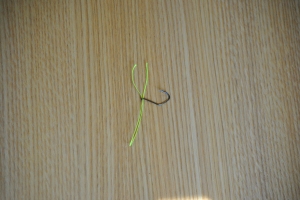

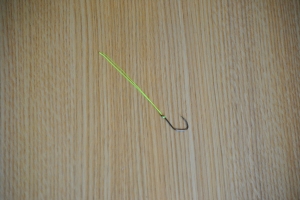



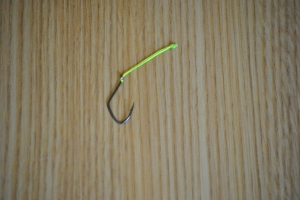



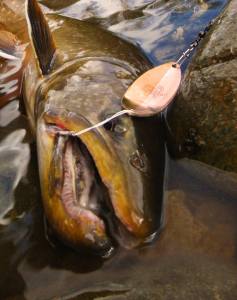

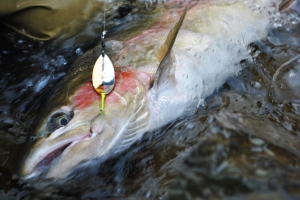
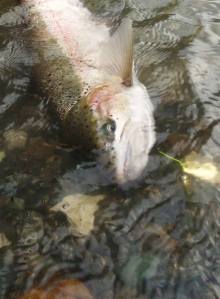


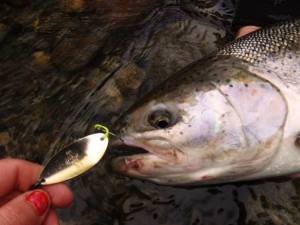
ever tried making the loop long enough to thread on a whole nightcrawler? it works! a while back I caught seven(7) fish with a 40year old STEE-LEE and a nightcrawler the last hour of daylight in the middle fork of the Willamette! all less than 20 feet from the shore! I tie a couple three bobberstop type knots on the line and only clip one of the tag ends flush…..makes a worm retaining barb of sorts.helps keep the worm from getting scrunched up and plugging the hookgap.
LikeLike
Looping to the bottom hole of the spoon seems to be a weak point having fairly sharp edges. Obviously you have been successful but why not use a split ring on the bottom of the hook then attach the trailing loop to it, logic says you would be less likely to break off than with your method ie; no sharp edges etc to cut the braid. Or do you have more fouling issues with the split ring? Just wondering….
LikeLike
The looping on the bottom of the spoon hasn’t had much of an issue. Some spoons are sharper than others, and we have had cut-throughs happen. I just normally check the dacron after fish or snags to make sure it’s not fraying.
I used to use the split ring at the bottom, but the loop didn’t sit properly, and I lost a number of fish by the dacron working it’s way out of the split ring during long fights. It also makes the overall length longer, meaning that you will also get more foul ups, and potential deep hookups/eye hookups, etc.
LikeLike
[…] been three years now since I originally wrote “The Trailing Hook Method.” Through this time period, I’ve had numerous questions relating to the method, and if […]
LikeLike
Dan, first of all thanks for posting this how-to. I’ve used trailer hooks on spoons now for the past two steelhead seasons on the Skeena and am a 100% convert. You and I have corresponded on these topics, but for your other readers here are a few suggestions:
1. I find it easier to mass produce the loops on a standalone basis, then put a hook on them. If you have a handful of loops and hooks, you can have a box full of hookless spoons (which don’t tangle) and then thread a hook on in seconds when you decide to use that particular spoon.
2. I like sealing the double overhand knot with a drop of Aquaseal. Let it dry overnight. This makes it 100% slip-proof and provides peace of mind (though I’ve not had an unglued knot pull out on a fish)
3. If you use a short length of mono as a guide, you can use small-eyed hooks without needing to change your eyeglass prescription. Run the mono through the looped hook, then pair the ends of the mono and push them through the hook eye. Pull the mono through and the loop follows.
4. I had a bad experience with the Matzuo’s so switched to Owner and Gamakatsu and am very happy.
5. Keep the loops small (just big enough to fit the hook through) to protect the fish. When I started, I had loops about 1 1/2″ in diameter (vs. 1″ today), and deeply hooked a couple fish.
6. Replace the loops if you see fraying in the Dacron (esp. after a couple of hooked fish).
Thanks again for such a great tip! My spoon hookups and fish-landed ratios both improved when I switched from Gamakatsu Siwash to much smaller looped hooks. The fish are healthier, too.
LikeLike
Thank you for your comments Brad! I’ve been meaning to write a follow up article addressing all the questions and comments I’ve had over the years, but just haven’t found the time to do it yet! Hopefully people will see these suggestions you’ve made as they are all good ones!
LikeLike
[…] For the spoon rigging method seen in banner picture: The Trailing Hook Method […]
LikeLike
[…] Link to the Trailing hook method seen in cover photo – The Trailing Hook Method […]
LikeLike
I’m curious, have you used this method with spinners? If so, how does it work? I would imagine the results are the same.
LikeLike
I have indeed used the method with spinners. I found that it wasn’t nearly as effective. I believe the main reason for this is that the fish are hitting the blade of the spinner. Putting the hook farther back from the blade in this case doesn’t work as well. On spoons, it’s a swing approach where the fish are seeing a large chunk of metal, and biting at the back (which is the first thing coming at them).
I also found I had major twist issues with the dacron. It would twist from the action of the spinner and then bunch up, leaving the hook in an awkward position. Sometimes the twist was so severe that it would flip the hook right up onto the top of the spinner.
That being said, it did work – and it held onto fish super well when I did hook them. I found the problems outweighed the benefits with spinners though. The thing with spinners is I rarely deep hook fish anyway. I believe it has to do with the “sheathing” action of the blade. The wide spin radius seems to prevent spinners from being swallowed. Most spinners also come with reasonably sized hooks in my experience as well. Definitely check out trophy tackle spinners (trophytackle.ca) and R&B spinners from firststrikelures.com. Awesome lures, reasonably priced, and come with high quality components and perfectly sized hooks that you don’t need to change out to begin with!
LikeLike
[…] chrome doe hammered the spoon and began her dance. Thankfully I have setup all my spoons with Dan’s trailing hook method. This method gives me the confidence that as much as she flails, there’s a great chance I […]
LikeLike
Other than the benefits aforementioned, I rarely lost any spoon now : when it snags on rocks, the thinner trailer braid breaks first so that I still keep the spoon. Less garbage on the river and more money in the pocket.
Thanks !!
LikeLike
Great article and something I will definitely try.
Thanks,
Jeff
LikeLike